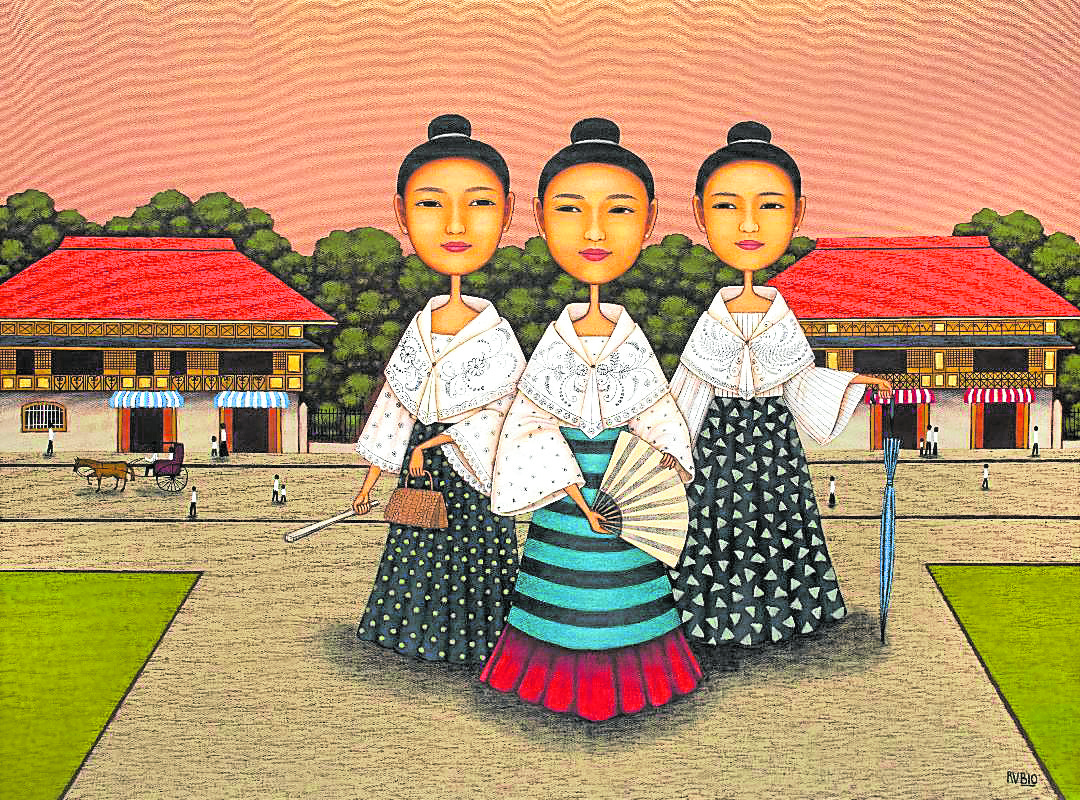Nostalgia and heritage as sources of optimism and resilience seem to be the theme of Dominic Rubio’s “New Day Dawning,” the inaugural exhibit of Galerie Joaquin’s newest branch at One Bonifacio High Street Mall in Bonifacio Global City, Taguig.

Rising from the punishing effects of the COVID-19 pandemic, the country seems set for a rebound or at least, for some relief, respite and recovery. It cannot be otherwise. It has faced down the medical threat just as it has done so with several other crises and calamities before, natural and man-made. Hope and optimism are deeply ingrained in the Filipino.
In his new series of paintings, Rubio’s signature colonial long-neck characters of ilustrados, ginoo and ginang, traders and coolies, and families from all walks of life, all garbed in colorful Filipiniana, seem to harken back to a vanished age of grace and beauty, anachronisms in today’s stressful era of climate change, runaway viruses, hate speech and naked violence.
Romantic figures
But Rubio’s romantic figures seem unperturbed by the din and blare of their era’s concerns and anxieties; even if they are, they go about their quotidian activities with determination and optimism. They seem confident that the old values of hard work, perseverance, filial devotion, and service and charity to others will carry them through thick and thin.
Such traditional values seem relevant in today’s new normal, which is really a mad rush for any form of normalcy that would erase if not bury the trauma of the pandemic.
But Rubio’s trademark iconography has been with us for 25 years now, and its longevity should prove cultural heritage’s continuing relevance and importance.

Rubio’s cast of colonial figures in colorful Filipiniana does not romanticize colonialism, but rather upholds what’s best and lasting in the culture and patrimony, the ceremony and grace, that it has fostered in the Filipino. Set against colonial architecture and town planning and the natural landscape, which provide both counterpoint and complement to one another, Rubio’s iconic figures become embodiments of strength of character and grace of self-possession. They become the epitome of Philippine culture and tradition.
Intangible cultural heritage
Culture and heritage as forms of healing have been proven during the pandemic. “Intangible cultural heritage” such as religious rituals, literature and communal dances, practices and observances provide “healing” or “therapy” to cope with the stress of the lockdown, according to Lawrence Charles Salazar of the National Commission for Culture and the Arts (NCCA).
Lucille Karen Malilong-Isberto, the former executive director of Nayong Pilipino, agreed. “Cultural heritage is a source of strength,” she said. “It should not be on the fringe of society’s concerns.”
Cultural heritage proved “essential” in helping people cope with anxieties while on lockdown, according to Arvin Manuel Villalon, consultant for cultural mapping of the NCCA and a member of the Technical Panel for Cultural Education of the Commission on Higher Education.
“Can we have the concept of a heritage front-liner?” he added. “Just as there are no restrictions to health front-liners coming to the aid of patients, heritage front-liners should operate without limitations to promote and protect cultural heritage during emergencies.”
“Heritage is what survives the test of time,” Salazar declared.
For his new series, most of Rubio’s paintings will have gold-flushed backgrounds to herald a new dawn for the country, a fresh beginning. As the nation continues to battle the pandemic, the exhibit and other art celebrations like it should point the way toward healing and recovery. Hope, after all, is what fuels art and its variegated struggles. —CONTRIBUTED
“New Day Dawning” by Dominic Rubio runs until Nov. 21 at Galerie Joaquin in One Bonifacio High Street Mall; tel. 0915-7391549; email [email protected].













































